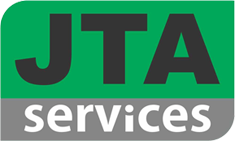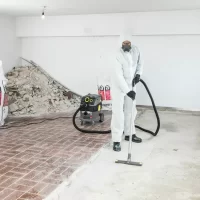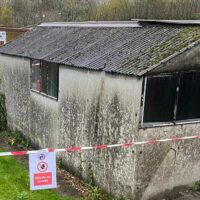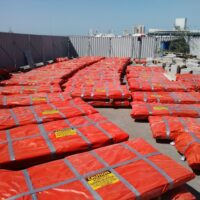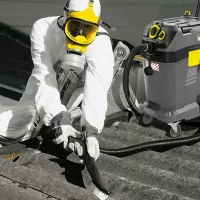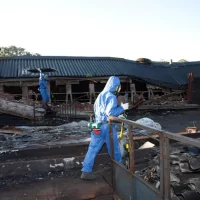Asbestos Removal
ASBESTOS CORRUGATED ROOF SHEET REMOVAL
When asbestos corrugated roof sheet removal is necessary, it is vital that this is done properly so you can ensure that your family and workforce are kept safe from the dangerous effects of asbestos. This type of asbestos removal is necessary when the roof sheets begin to deteriorate as this will expose the asbestos fibres.
Asbestos Fighters can keep this potentially deadly problem at bay for you by removing your asbestos corrugated roof safely and in keeping with the guidelines recommended by the Health & Safety Executive. Our team is highly trained at removing and disposing of all forms of asbestos, as well as carrying out asbestos surveys to check whether any asbestos is present in the first place.
If so, Asbestos Fighters can come and take a look and carry out the relevant tests to confirm whether it is present or not. If so, we can advise you on your options and if needed, carry out the asbestos corrugated roof sheet removal in a professional and safe way, ensuring minimum disruption and maximum safety to your family, home, business and colleagues.
By employing an experienced and licensed company to carry out the removal, you have the peace of mind that you have put no one’s health in danger and your asbestos water tank will be disposed of safely and to the HSE standards and guidelines.
The Asbestos Fighters team have all the essential equipment and workwear to ensure the removal of any asbestos items in your home and business are removed in the safest way. Contact the Asbestos Fighters team today to see how we can help remove your asbestos water tank and give you the peace of mind you need.
—For safety reasons, asbestos needs to be carefully wrapped prior to disposal. If you have not wrapped your asbestos, don’t worry—just let us know and we’ll do it for you on collection.
We also provide general rubbish collection services, so there’s no need to make several trips to the landfill site or call in another team to clear any remaining non-hazardous waste. We’ll take care of the whole lot for you, allowing you to focus on the rest of your project.
Our asbestos collection service is fast, affordable and convenient. We’ll arrange to collect the asbestos at a time that suits you, and our friendly team will work quickly and carefully, with minimum disruption to you and the site.
How to Handle and Dispose of Asbestos
The first and most important thing to know about handling and disposing of asbestos is that you should not do it yourself. Asbestos is a deadly carcinogen that should only be handled by licensed asbestos abatement professionals.
While you can find information online about do-it-yourself asbestos abatement, it is highly recommended that you do not attempt to disturb asbestos-containing materials in any way.
If you find friable asbestos products in your home, you may carefully wet them to prevent them from releasing fibers until you can get a licensed professional to assess your home.
These professionals are highly trained and certified to follow all federal and state laws governing asbestos abatement and disposal. If you don’t hire a professional, you are likely to break one of the many laws that regulate asbestos, and you run the risk of facing a serious fine or penalty.
handling and disposing of asbestos regulations include:
Planning the Project Appropriately: Licensed professionals know how to assess the size and severity of the abatement project. This matters a lot to local officials who supply permits for different types of asbestos-abatement projects.
Preparing the Work Area: The work area must be sealed off with plastic sheeting and negative air pressure units must be used to prevent contamination outside the work area. Surfaces that don’t need abating must be covered in plastic sheeting. Warning signs must be posted to alert others that an asbestos project is underway.
Wearing Personal Safety Protection: Workers must wear an N-100 or P-100 respirator and protective clothing to prevent asbestos exposure.
Safety Protocols in the Work Area: HVAC systems must be disabled to prevent circulation of asbestos fibers. Workers should use wet wipes or a HEPA vacuum to clean asbestos off immoveable objects to control dust. A HEPA vacuum is used to clean up the area when the abatement is finished.
How to Handle and Dispose of Asbestos Waste: Asbestos-containing materials are wetted prior to any removal efforts. Workers must be wearing a respirator and personal safety protection as they work with contaminated materials. All asbestos waste generated during the project must be wetted before it is double bagged in 6-millimeter plastic bags and enclosed in a plastic, leak-tight container with a lid and proper labeling. It can only be disposed of in special landfills that are designated to receive asbestos waste.
Creating Decontamination Units: Decontamination enclosure systems must be installed to allow workers to remove contaminated clothing, shoes and tools.
Following Decontamination Procedures: Professionals must follow specific steps to safely remove contaminated protective clothing and equipment. These procedures ensure worker safety and prevent workers from tracking asbestos into their homes.
